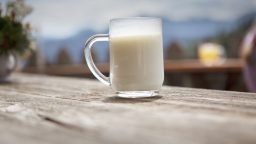Buttermilk isn’t something that you only need to buy at the store. Instead, you can make it yourself. The results will be much tastier and better for you. The buttermilk that you find in the dairy section (if your grocery store even carries it) is cultured. This type takes at least 24 hours to make, and you need to start with cultured buttermilk, making it a bit redundant, or active buttermilk culture. This process is fairly labor intensive. However, if you have a recipe that requires buttermilk and you don’t have any on hand, these quick methods will work nicely. You’ll have your own buttermilk within minutes. Are you ready?
Option Number One
This method produces buttermilk quickly and easily. It all starts with either lemon juice and vinegar, as well as some milk. For every cup of milk, add one tablespoon of lemon juice or vinegar to it. Place them in the same glass and let it sit on your counter for ten minutes. While the results aren’t properly cultured buttermilk (this is actually an acidified version), you’ll end up with a type that will work nicely in recipes. The acid in the milk will work to activate the baking soda or baking powder in the batter, just like it’s supposed to.
Option Number Two
You’ll need a few more ingredients for this buttermilk. It all starts with yogurt or sour cream and some milk. Heck, even the milk is optional – you can use water instead. The ratios are 3/4 of a cup of yogurt or sour cream to a ¼ cup of milk or water. As with the previous recipe, combine the liquid and the semi-solid in a cup and let it sit on your counter for ten minutes. You may have to stir them a bit to make everything smooth, but in the end, you’ll end up with enough buttermilk for any recipe.
Now For Something Different
The two previous methods described how you could make buttermilk just by letting your dairy products curdle for a few minutes. The next two are more complicated, as you’ll be making actual cultured buttermilk, just like the kind that you see in the grocery store.
Option Number Three
This recipe starts with cultured buttermilk. Yes, this is the same thing that you’ll be making, only you’ll end up with much more it. Think of it as a good way to never run out of buttermilk. Pour six ounces of cultured buttermilk into a glass jar. A quart jar will work perfectly. Then add in three cups of whole milk. The fresher the buttermilk, the better, since the cultures will be more effective and the process will work properly. Once you have the buttermilk and the milk in the jar, put the lid on and shake it well. Then, find a safe spot to place it. The mixture needs to sit out for 24 hours at room temperature.
At the end of that time period, check your buttermilk. It should be thick enough to coat the walls of glass and taste just like typically cultured buttermilk. If you don’t need to use it right away, place it in the refrigerator. It should last for several weeks in there.
Option Number Four
This method is very similar to the previous one; only you use active buttermilk cultures instead of the buttermilk itself. The mixture needs to sit out for between 12 and 24 hours, and you need to get the ratio of cultures to milk correct. This usually is written on the packaging.
Ideally, you’ll never run out of buttermilk thanks to these helpful methods.
HOW TO START A HIGH-PERFORMANCEHOMESTEAD FROM THE GROUND UP…Learn More Here>>>
Here is a great video showing how simple and easy making your own buttermilk really is…
https://youtu.be/zJbw9rXQjYI







